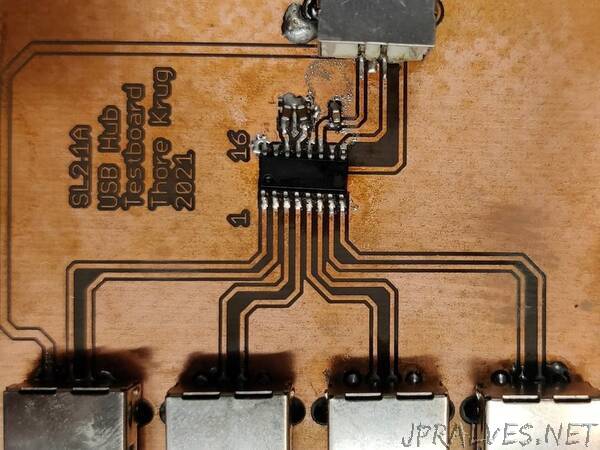
“Building a USB hub using a 30 cent IC which just requires a few passive components to function.
USB hubs are a common Item for most makers/hackers, they expand the number of USB Ports which are available. You need more USB Ports for your project? Use a USB hub. While commercially available USB hubs are perfectly suited for most projects, sometimes you want to create a custom Board, this involves the designing of a PCB, many of the available ICs (Integrated Circuit) however are sold in a small SMD Package which makes them less accessible to the Standard maker.
But this doesn’t mean there are no options out there, many projects use the Fe1.1s as this IC is available in a SSOP28 which can be soldered with a bit of practice. I myself planned on using the FE1.1s for some of my projects. A few weeks ago I however stumbled across an even Maker friendlier IC, the SL2.1A, like the FE1.1s it has 4 downstream USB2.0 ports, but does not come with a LED interface to indicate the status or an EEPROM Interface, what makes it interesting though is that it uses a SOP16 package which can comfortably be hand soldered without much practice. Another benefit is the integrated clock as well, eliminating the need for an external crystal, which reduces the number of external circuitry even further. According to the data sheet 2 external 10uF Capacitors are needed for the IC to function.
With this in mind I wanted to check this IC out, I ordered a few and started to create a simple PCB. The data sheet gives an example circuit which I replicated in KiCad. I did some Changes as I left out the 10uF Capacitors at the downstream ports as I just want to create a test PCB. I added a 100nF capacitor however in the supply rail of the IC as this is a good practice to reduce noise. The SL2.1A has an Interface for a crystal which is recommended as it provides a better more accurate clock to the IC. But I forgot to order the crystals, thankfully I can enable the internal clock by connecting the Input XI to Ground (GND).”
